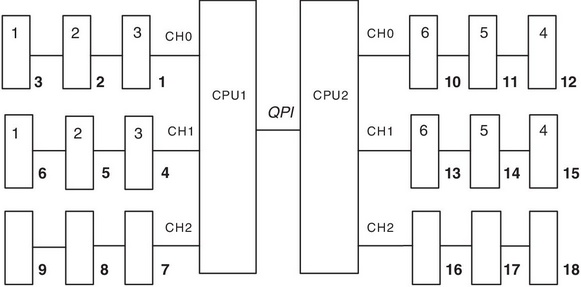Memory mirroring
Memory-mirroring mode replicates and stores data on two pairs of DIMMs within two channels simultaneously. If a failure occurs, the memory controller switches from the primary pair of memory DIMMs to the backup pair of DIMMs.
- When you use memory mirroring, you must install a pair of DIMMs at a time. One DIMM must be in channel 0, and the mirroring DIMM must be in the same slot in channel 1. The two DIMMs in each pair must be identical in size, type, and rank (single or dual), and organization, but not in speed. The channels run at the speed of the slowest DIMM in any of the channels.
- Channel 2, DIMM connectors 7, 8, 9, 16, 17, and 18 are not used in memory-mirroring mode.
- The maximum available memory is reduced to half of the installed memory when memory mirroring is enabled. For example, if you install 64 GB of memory using RDIMMs, only 32 GB of addressable memory is available when you use memory mirroring.
The following diagram shows the memory channel interface layout with the DIMM installation sequence for mirroring mode. The numbers within the boxes indicate the DIMM population sequence in pairs within the channels, and the numbers next to the boxes indicate the DIMM connectors within the channels. For example, the following illustration shows the first pair of DIMMs (indicated by ones (1) inside the boxes) should be installed in DIMM connectors 1 on channel 0 and DIMM connector 2 on channel 1. DIMM connectors 3, 6, 9, 12, 15, and 18 on channel 2 are not used in memory-mirroring mode.

The following table lists the DIMM connectors on each memory channel.
| Memory channel | DIMM connector |
|---|---|
| Channel 0 | 1, 2, 3, 10, 11, 12 |
| Channel 1 | 4, 5, 6, 13, 14, 15 |
| Channel 2 | 7, 8, 9, 16, 17, 18 |
The following illustration shows the memory connector layout that is associated with each microprocessor. For example, DIMM connectors 10, 11, 12, 13, 14, 15, 16, 17, and 18 (DIMM connectors are shown underneath the boxes) are associated with microprocessor 2 (CPU2) and DIMM connectors 1, 2, 3, 4, 5, 6, 7, 8, and 9 are associated with microprocessor 1 (CPU1). The numbers within the boxes indicate the installation sequence of the DIMM pairs. For example, the first DIMM pair (indicated within the boxes by ones (1)) should be installed in DIMM connectors 1 and 2, which is associated with microprocessor 1 (CPU1).

| Number of DIMMs | Number of installed microprocessor | DIMM connector |
|---|---|---|
| First pair of DIMMs | 1 | 3, 6 |
| Second pair of DIMMs | 1 | 2, 5 |
| Third pair of DIMMs | 1 | 1, 4 |
| Fourth pair of DIMMs | 2 | 12, 15 |
| Fifth pair of DIMMs | 2 | 11, 14 |
| Sixth pair of DIMMs | 2 | 10, 13 |
Table note DIMM connectors 7, 8, 9, 16, 17, and 18 are not used in memory-mirroring mode. | ||